英语教学法_图文.ppt
- 格式:ppt
- 大小:1009.09 KB
- 文档页数:14

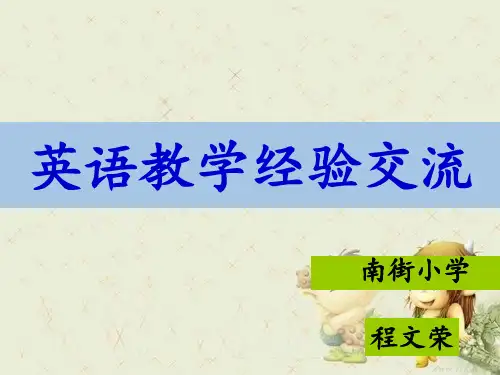
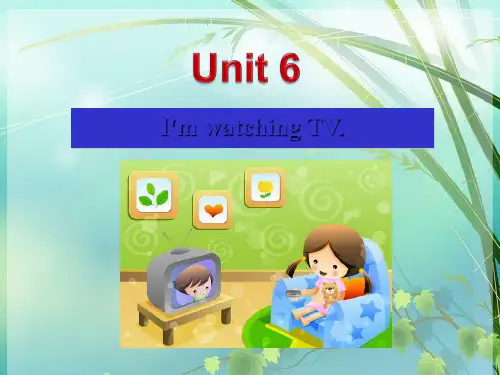

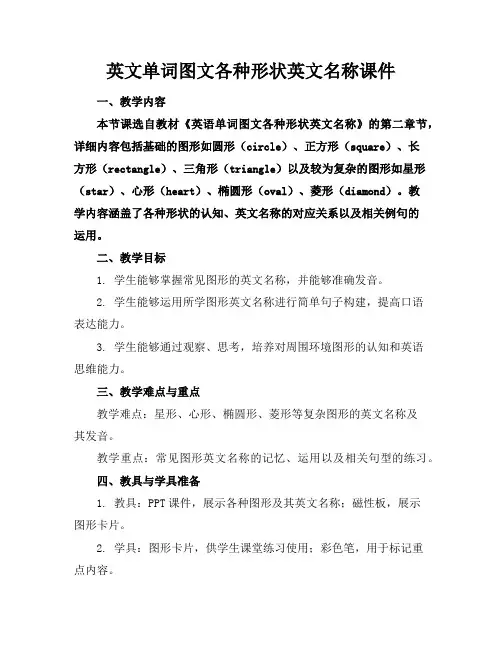
英文单词图文各种形状英文名称课件一、教学内容本节课选自教材《英语单词图文各种形状英文名称》的第二章节,详细内容包括基础的图形如圆形(circle)、正方形(square)、长方形(rectangle)、三角形(triangle)以及较为复杂的图形如星形(star)、心形(heart)、椭圆形(oval)、菱形(diamond)。
教学内容涵盖了各种形状的认知、英文名称的对应关系以及相关例句的运用。
二、教学目标1. 学生能够掌握常见图形的英文名称,并能够准确发音。
2. 学生能够运用所学图形英文名称进行简单句子构建,提高口语表达能力。
3. 学生能够通过观察、思考,培养对周围环境图形的认知和英语思维能力。
三、教学难点与重点教学难点:星形、心形、椭圆形、菱形等复杂图形的英文名称及其发音。
教学重点:常见图形英文名称的记忆、运用以及相关句型的练习。
四、教具与学具准备1. 教具:PPT课件,展示各种图形及其英文名称;磁性板,展示图形卡片。
2. 学具:图形卡片,供学生课堂练习使用;彩色笔,用于标记重点内容。
五、教学过程1. 导入:通过PPT展示一组日常生活中常见的图形,引导学生用英文说出所看到的图形,激发学生兴趣。
2. 讲解:详细讲解各种图形的英文名称,并进行示范发音,让学生跟读,确保发音准确。
3. 实践:分组进行图形认知游戏,教师随机展示图形卡片,学生迅速用英文说出图形名称,巩固所学内容。
4. 例题讲解:用PPT展示例题,如:“This is a circle. What is the shape?”引导学生运用所学知识进行回答。
5. 随堂练习:发放图形卡片,学生自行练习,并在小组内进行交流,提高口语表达能力。
六、板书设计板书分为两部分:一部分为各种图形的英文名称,另一部分为相关句型。
板书设计简洁明了,突出重点,方便学生记忆。
七、作业设计(1)圆形:________________(2)正方形:________________(3)星形:________________2. 答案:(1)圆形:This is a shape that has no corners and all the points are equidistant from the center. Its English name is "circle".(2)正方形:This shape has four equal sides and four right angles. Its English name is "square".(3)星形:This shape looks like a star, with five points extending from a central point. Its English name is "star".八、课后反思及拓展延伸本节课通过丰富的教学活动,让学生在轻松愉快的氛围中学习图形英文名称,提高了学生的英语口语表达能力。
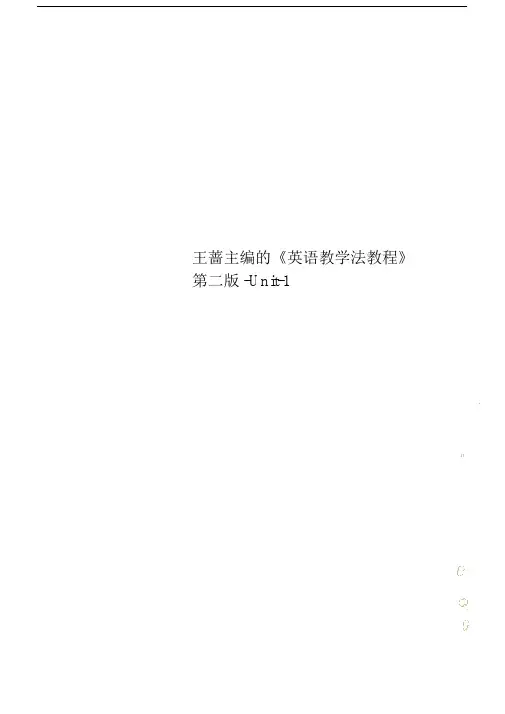
王蔷主编的《英语教学法教程》第二版 -Unit-1Unit 1 Language and Language LearningAims of the unitIn this unit we will discusssome general matters about language learning and teaching. We are going to discuss five questions on particular:1.How do we learn language?2.What are the common views on language?3.What are the common views on language learning?4.What are the qualities of a good language teacher?5.How can one become a good language teacher?1.1 How do we learn languages?Mach of human behavior is influenced by their experiences. The way language teachers teach in the classroomis to some extent influenced by the way they learned languages. This is especially true in foreign language teaching. Before we discuss language learning theories, let us first reflect on our own language learning experience.Task 1Below is a list of interview questions on how people learn a foreign language.In the first column, write down your own responses.Then interview three other students in your class and enter their responsesin the other columns. Discuss your findings in group of 4 and draw some conclusion.You ST1 ST2ST31.How many foreign languages can you speak so far?2.When did you start learning the foreign language(s)?3.How do you feel about learning a foreign language?4.What difficulties have you experienced in learning?5.Which skill do you find more difficult to learn?6.Have you focused on knowledge or skills? Why?7.Why do you learn the foreign language(s)?8.Do you consider yourself a successful learner? Why?9.What are your most common learning activities?10.Do you like the way you learned the foreignlanguage(s)?From the above task, you may have found that 1) people started learning a foreign language at different ages; 2) people have different experiences in learning a foreign language, some find it easy, some find it difficult; 3) people learn languages for different reasons; 4) people learn languages in different ways; 5) people have different understandings about language learning; 6) people havedifferent capacities in language learning; 7) learning can be affected by theway it is taught; 8) learning is affected by the degree of successone isexpected to achieve; and more. Thus the challenge confronting language teaching is how teaching methodology can ensure successfullearning by allthe learners who have more differences than the commonality.1.2 views on languageThe question that all approaches to language teaching should answer ‘is,what is language?’The answer to this question is the basis for syllabus designs, teaching methodology,teaching and assessmentprocedures in the classroom. Different views on language generate different teaching methodologies.Task 2Work in group of 4. Brainstorm possible answer to the question: what is language? When you are ready, join another group and share your ideas.To give a concise definition of language has always been difficult for linguists and philogists. Although there has been an enormous amount of research in language in the past century, no authoritative answer has been given ‘towhat is language?’ rather, people have settle down to talk about views of language, seemingly allowing for or accepting different theories for the moment. However, language teachers clearly need to know generally what sort of entity they are dealing with and how the particular language they are teaching fits into that entity (Brown, 1994a). for sample definition of‘language’ , please refer to Appendix 1.Structural viewThe structural view of language sees language as a linguistic system made up of various subsystems (Larsen-Freeman & Long, 1991): the sound system (phonology); the discrete units of meaning produced by sound combinations (morphology), and the system of combining units of meaning for communication (syntax). Each language has a finite number of such structural items. To learn a language means to learn these structural items so as to be able to understand and produce language. When this structural view of language was combined with the stimulus-response principles of behaviorist psychology, the audio-lingual approach to language learning emerged.Functional viewIn the 1960s, British linguists developed a system of categories based on the communicative needs of the learner (Johnson and Marrow, 1981) and proposed asyllabus based on communicative functions. The functional view not only sees languages as a linguistic system but also a means for doing things. Most of our day-to-day language use involves functional activities: offering, suggesting, advising, apologizing, etc. therefore, learners learn a language in order to be able to do with it. In order to perform functions, learners need to know how to combine the grammatical rules and the vocabulary to express notions that perform the functions. Examples of notions are the concept of present, past and future time, the expressionsof certainty and possibility, the roles of agents, instruments with a sentence, and special relationships between people and objects.Interactional viewThe interactional view considers language to be a communicative tool, whose main use is to build up and maintain social relations between people. Therefore, learners not only need to know the grammar and vocabulary of the language but as importantly they need to know the rules for using them in a whole range of communicative contexts.These three views present an ever wider view of language. The structural view limits knowing a language to knowing its structural rules and vocabulary. The communicative or notional-functional view adds the need to know how to use the rules and vocabulary to do whatever it is one wants to do. The interactional view says that to know how to do what you want to do involves also knowing whether it is appropriate to do, and where, when and how it is appropriate to do it. In order to know this, you have to study the patterns and rules of language above the sentence level to learn how language is used in different speech contexts.The understanding of the nature of language may provide the basis for a particular teaching method (Richard and Rodgers, 1986), but more importantly, it is closely related to the understanding of language learning. If language is considered to have a finite number of structural items, learning the language probably means learning these items. If language is more than just a system of structures, it is more importantly a tool then to learn the language learning. If language is more than just a system of structures, it is more importantly a tool, then to learn the language means to use it, rather than just study what it is and how it is formed. The next section discussessome current theories about language learning.1.3 Views on Language learning and learning in generalA language learning theory underlying an approach or method usually answers two questions; 1) What are the psycholinguistic and cognitive processes involved in language learning? 2) What are the conditions that need to be met in order for these learning processes to be activated?Task3Work in groups of 4. Brainstorm the answers to the two questions stated above. When you are ready, join another group and share your ideas.Although these two questions have never been satisfactorily answered, a vast amount of research has been done from all aspects. The research can be broadly divided into process-oriented theories and condition-oriented theories. Process-oriented theories are concerned with how the mind organizes new information such as habit formation, induction, making inference, hypothesis testing and generalization. Condition-oriented theories emphasize the nature of the human and physical context in which language learning takes place, such as the number of students, the kind of input learners receive, and the atmosphere. Some researchers attempt to formulate teaching approaches directly from these theories. For example, the Natural Approach, Total Physical Response, and the Silent Way are based on one or more dimensions of processes and conditions. At this level, it is too early to formulate a specific approach, because some aspects are still too vague, for example, what is done in these processes.Behaviorist theoryThe behaviorist theory of language learning was initiated by behavioural psychologist Skinner, who applied Watson and Raynor’s theory of conditioning to the way human acquire language (Harmer, 1983). Based on their experiments, Watson and Raynor formulated a stimulus-response theory of psychology. Inthis theory all complex forms of behavior— motions, habits and such—are seen as composed of simple muscular and glandular elements that can be observed and measured. They claimed that emotional reactions are learned in much the same way as other skills. The key point of the theory of conditioning is that ‘you can train an animal to do anything (within reason) if you follow a certain procedure which has three major stages,stimulus, response,and reinforcement’(Harmer, 1983:30).Based on the theory of conditioning, Skinner suggestedthat language is also a form of behavior. It can be learned the same way as an animal is trained to respond to stimuli. This theory of learning is referred to as behaviorism, which was adopted for some time by the language teaching profession, particularly in the U.S. One influential result is the audio-lingual method, which involves endless’listen and repeat’drilling activities. The idea of this method is that language is learned by constant repetition and the reinforcement of the teacher. Mistakes were immediately corrected, and correct utterances were immediately praised. This method is still used in many parts of the world today.Cognitive theoryThe term cognitivism is often used loosely to describe methods in which students are asked to think rather than simply repeat. It seems to be largely the result of Noam Chomsky’s reaction to Skinner’s behaviorist theory, which led tothe revival of structural linguistics. The key point of Chomsky’s theory is reflected in his most famous question: if all language is a learned behavior, how can achild produce a sentence that never been said by others before?According to Chomsky, language is not a form of behavior, it is an intricate rule-based system and a large part of language acquisition is the learning of this system. There are a finite number of grammatical rules in the system and with a knowledge of these an infinite number of sentences can be produced. A language learner acquires language competence which enables him to produce language.Though Chomsky’s theory is not directly applied in language teaching, it has had a great impact on the profession. One influential idea is that students should be allowed to create their own sentencesbased on their understanding of certain rules. This idea is clearly in opposition to the audio-lingual method.Although people are pretty much still in the dark as to what language is andhow language is learned, it is believed that general knowledge about language and language learning will help language teachers do a better job.Constructivist theoryThe constructivist theory believes that learning is a process in which the learner constructsmeaning based on his/her own experiencesand what he/she already knows. Although constructivist theory was not developed for the understanding of language learning, it is widely applicable to learning in general. It is believed that education is used to develop the mind, not just to rote recall what is learned. John Dewey provided a foundation for constructivism. He believed that teaching should be built based on what learners already knew and engage learners in learning activities. Teachers need to design environments and interact with learners to foster inventive, creative, critical learners. Therefore, teachers must balance an understanding of the habits, characteristics as well as personalitiesof individual learners with an understanding of the means of arousing learner’s interests and curiosity for learning (Archambault, 1964).Socio-constructivist theorySimilar to constructivist theory, socio-constructivisttheory represented by Vygotsky (1978) emphasizes interaction and engagement with the target language in a social context based on the concept of ‘Zone of Proximal Development’(ZPD) and scaffolding. In other words, learning is best achieved through the dynamic interaction between the teacher and the learner andbetween learners. With the teacher’s scaffolding through questions and explanations, or with a more capable peer’s support, the learner can move toa higher level of understanding and extend his/her skills and knowledge and knowledge to the fullest potential.1.4 What makes a good language teacher?Some people with an excellent command of a foreign language may not be able to teach the language well while others with a general command of the language can teach it very effectively. What do you think might account for this phenomenon?Task 4Work in groups. Reflect on your own learning experience from early school years to the university. Have you had an excellent English teacher? Try to identify as many qualities as possible of your best English teacher(s). Note down all the qualities that you think are important for a good English teacher.It is clear that whether someonecan become a good foreign language teacher does not solely depend on his\her command of the language. There are avariety of elementsthat contributes to the qualities of a good language teacher. These elements can be categorized into three groups: ethic devotion, professional qualities and personal styles (Parrot, 1993).Task 5Ethic devotion, professional qualities and personal styles jointly contribute to the making of a good English teacher. All the adjectives in the box below could be used to characterize these three aspects.1. Work in groups of 4 and decide which adjectives describe ethic devotion,which describe personal styles and which describe professional qualities.Please write your answers on a separate piece of paper.2.Add any adjectives to the list which describe further qualities that you feelare missing.3.These adjectives are intended to describe positive qualities or styles. Doyou feel that any of them could have a negative side as well? If yes, in what way? For example, an authoritative teacher may make the students feelassured, but may also make the student less free to disagree with him\her.kind dynamic authoritative hardworkingcreative patient well-informed fairresourceful attentive warm-hearted reflectivewell-prepared flexible intuitiveaccurate enthusiastic humorouscaring disciplined professionally-trained(Adapted from Tasks for Language Teachers, Martin Parrot, 1993)From the above activities we can see that a good English teacher should have ethic devotion, certain desirable personal styles, and more importantly, he or she should have necessary professional qualities. These three aspects constitute the professionalcompetenceof a good English teacher. A person who has a good command of English is not necessarily a good teacher because he has only one of the elements of professional competence.It is assumed that all responsibleEnglish teachers have ethic devotion, and they are supposedto make their personal styles compatible with their work. Thesetwo aspects, which are beyond the scope of this book, can be achieved as long as the teacher himself\herself has the willingness to do so.A question that many teachers often ask is: I like my job, and I love the students, but how can I becomea good English teacher? Our answer is thatthey need professional competence, which we are going to discuss in thenext section.1.5 How can one become a good language teacher?The most important and most difficult part of the making of a good language teacher is the development of professional competence,which is the state or quality of being adequately qualified for the profession, and armed with a specific range of skills, strategies, knowledge, and ability.Task 6Work in pairs and discuss how one can become a professionally competent teacher of English. For example, we have to develop our English proficiencyfirst and also we may need to learn from experienced teachers through observations. What else can you think of? Make a list and then pool all yourideas together to find out about your common beliefs.A language teacher’s professional competence is much more difficult than a driver ’s skill to handle a car, and is more complicated than a student’s competenceof speaking foreign language. It involves more factors and longer learning time, and may never be finished.Some people think teaching is a craft; that is, a novice teacher can learn theprofessionby imitating the experts’techniques, just like an apprentice. Othershold the view that teaching is an applied science, based on scientific knowledge and experimentation. By making a compromise between these two views, Wallace (1991) uses a “ reflectivemodel” to demonstrate the development of professional competence. The following model is an adapted version toillustrate the process of becoming a professionally competent teacher.Figure 1.1 Teacher’s professional development(Adapted from Wallace, 1991:15)From the above model, we can see the development of professional competence for a language teacher involves Stage 1, Stage 2 and Goal. The first stage is language development. All English teachers are supposed to have a sound command of English. As language is the subject matter for language teachers and also because language is always changing, language development can never come to an end.The second stage is the most crucial stage and it is more complicated because it involves three sub-stages: learning, practice, and reflection. The learning stageis actually the purposeful preparation that a language teacher normally receives before he\she starts the practice of teaching. This preparation can include:1.learning from others’experiences (empirical knowledge gained throughreading and observations)2.learning the received knowledge (language learning theories, educationalpsychology, language teaching methodology, etc.)3.learning from one’s own experiences as a learnerBoth experiential knowledge (others’and one’s own) and received knowledge are useful when a teacher goes to practice. This is the combination of ‘craft’and‘applied science’knowledge. The learning stage is followed by practice. The term ‘practice’can be used in two senses.In one sense,it is a short period of time assignedto do teaching practice as part of one’s pre-service education, usually under the supervision of instructors. This practice is also called pseudo practice. The other sense of ‘practice’is the real classroom teaching that a teacher undertakes after he/she finishes formal education.Teachers benefit from practice if they keep on reflecting on what they havebeen doing (Stanely, 1999). It should be noted that teachers reflect on their work not only after they finish a certain period of practice, but also while they are doing the practice.When the would-be teachers(trainees) are doing pseudo practice, they are often trying out ideas that they have learned in a methodology class. Therefore, they are likely to reflect on how well a certain idea or technique works and often their instructors may require them to do so. The pseudo practice is beneficial only if the student teachers take reflections seriously. The most difficult thing is to keep on reflecting on one’s work when one moves on to real classroom teaching.Ideally, a teacher should be able to attain his/her professional competence after some period of practice and reflection as shown in Figure 1.1. However, professional competence as an ultimate goal does not seem to have an end. With the ever-deepening of our understanding of teaching and learning, and with the ever changing needs of the society, of education, of students, and of the teaching requirements, one must keep on learning, practicing and reflecting. Actually professional competence is’ a moving target or horizon, towards which professionals travel all their professional life but which is never finally attained‘. (Wallace, 1991:58)Task 7Work in groups. Discuss possible answers to the following questions in relation to the model presented in Figure 1.1.1. Whyare stage 1 and stage 2 interrelated by a double arrow line?2. Why are practice and reflection connected by a circle?3. Why is professional competence ’ a moving target or horizon,towards which professional travel all their professional life butwhich is never finally attained?'4. Where should a TEFL methodology course fill in the model?1.6 An overview of the bookThis second edition of A Course in English Language Teaching has allowed usthe opportunity to expand the original 14 units into 18 in order to include topics reflecting the recent development in English language teaching both at home and abroad, to revisit a number of areas, to expand an clarify points that we felt were not sufficiently clear in the first edition, and to improve the pedagogical usefulness of the text.Overall, the book aims at introducing practical methods to teachers of Englishas a foreign language with some basic theories presented in the first two units. Itis hoped that classroom teachers or would-be teachers will not simply copy or imitate what are suggested but be able to choose or adapt with anunderstanding of why.Unit 1 serves as an introduction for setting the scene for this methodology course. It discusses issues concerning views on language and language learning or learning in general with the belief that such views will affect teachers’ways of teaching and thus learners’ways of learning. The qualities of a good language teacher is also discussed in order to raise the participants’awareness of what is required for a good English teacher.Communicative Language Teaching (CLT) and Task-based Language Teaching (TBLT) have been the most influential language teaching approaches in the past two decades and they have proven to be effective in a variety of languageteaching contexts. In Unit 2 we introduce the basic principles of CLT andactivities followed by an introduction to task-based approach. It is intended that most of the methods that we introduce in the remaining units will, to some extent, follow a communicative approach and task-based language teaching.Unit 3 is a new unit which focuses on the new National English Curriculum. It begins with a brief overview of the history of English language teaching in China followed by tasks and discussions on the goals, objectives, and design of thenew English curriculum and ends with discussions on the challenges facing teachers today.We have arranged lesson planning and classroom management as the next two units of the book-Unit 4 and Unit 5 respectively. With regard to these two units,the new edition has replaced some previous lesson plan samples and addedsome relevant issues, i.e. giving effective instructions, asking effective questions, and dealing with students’errors in the classroom. To have these two parts in the early units, our intention is that the reader will use what is covered in these two parts in the early units, our intention is that the reader will use what is coveredin these two units to design mini classroom activities for the teachingof knowledge and skills that come in later units.Like the first edition of the book, Units 6, 7 and 8 focus on the teaching oflanguage components, that is, the teaching of pronunciation, grammar, and vocabulary, while Units 9, 10, 11, 12 focus on the teaching of four skills of language, namely, listening, speaking, reading and writing, with Unit 13 discussing the integration of the four skills. Some new examples and new points are added to all these units in the new edition. It should be noted that neither the language components nor the language skills are taught in an isolated fashion. We present the teaching of these language components and skills in separate units so that there is a clearer focus of discussion. In classroom teaching, we hope teacherswill be able to integrate all areas.Unit 14 is about moral education. This is a new unit aiming at raising teachers’awareness of the scope available for moral education in language teaching sothat teachers will be able to create opportunities and use relevant materials and activities to help students form positive social values towards life and work.Unit 15 deals with language assessment. We have avoided‘testing’and‘examination’as our unit title because we believe‘assessment’is a broader concept. In this unit we focus on classroom assessment rather than standard tests. Research evidence shows that classroom-based assessment provides a better evaluation of what the students have achieved during the course of study.Units 16 and 17 are also new units. Unit 16 is about learner differences andlearner training. As the purpose of teaching is for learning to take place, learners will need to play a major role in the learning process. We think as teachers weneed to understand learners and the differences among them so that appropriate methods and techniques can be selected or designed to cater for learner needs. Also, we teach in order not to teach. In this sense, we need to help learners develop awareness of different learning strategies and learn to takeresponsibility for their own learning . Unit 17 focuses on using and creating resources. It discusses how to use the available resources as well as how to explore hidden resources for teaching and learning.Unit 18 introduces the reader to the most basic things in the evaluation,selection and adaptation of textbooks used in language teaching and learning. In the future, classroom teachers will have to take more responsibility and be given more autonomy in selecting and adopting ELT textbooks for their students.Throughout the book, we provide a number of tasks for each unit. The tasks usually follow a discussion and are aimed at providing the reader with opportunities torelate theory to practice. Most of the tasks are open-ended, that is, they do not have fixed answers or solutions. Sometimes, discussions following the task provide the authors’further comments. Occasionally, some tasks seem toneed more‘concrete’solutions. In that case, we remove the solutions to Appendix 1 at the back of the book. We intend that users of the book should solve the problems themselves before referring to the authors’uggested solutions.Most of the tasks involve group work or pair work. If the book is used in class, we consider it very important for students to work in pairs or groups so that they can share knowledge and experience. Individual readers may find it inconvenient to perform the task. We suggest that they discuss the problems with their colleagues wherever possible.。

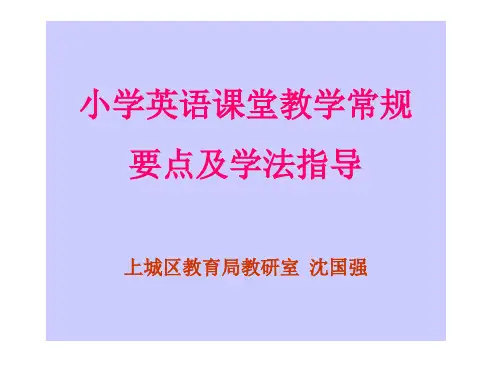

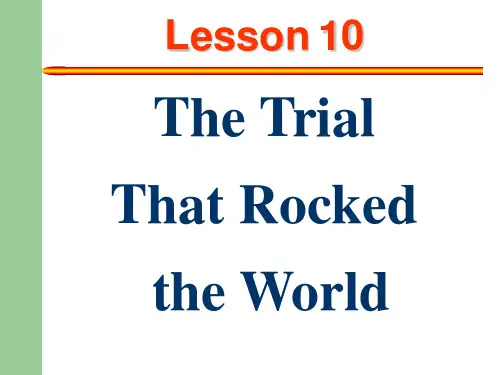

英语五步教学法介绍欧阳家百(2021.03.07)一般说来,除了第一节课以外,每一节课教师所要进行教学的内容不外乎三部分:1. 复习已教过的语言材料;2. 教学新的语言项目如词汇、语音、语法或句型等;3. 进行各种形式的听、说、读、写训练活动。
为教学上述三部分内容,一般采用以下五个步骤(即五步教学法):步骤1 (Step 1): 复习 (Revision)步骤2 (Step 2): 介绍 (Presentation)步骤3 (Step 3): 操练 (Drill)步骤4 (Step 4): 练习 (Practice)步骤5 (Step 5): 巩固 (Consolidation)在每一个步骤当中,教师的作用都有所不同。
一位成功的教师一定是一位“多面手”,不但会讲解、还会指挥、会导演、会组织、会表演、会监督、会评判、会记分、会帮忙、会引导,而且还是一位很好的帮助学生强化记忆的人。
教师在课堂上能够扮演上述各种角色,就能够顺利地上好一节课,完成一节课的整体教学任务。
教师在各个步骤中的作用,请看下表:教师在进行上述五个步骤的教学中,自始至终观察全班学生的反应,保证所教的内容大家都能理解。
如果相当一部分学生还没有弄懂,那么教师就需要重教。
因此,教师要随时根据情况变换自己的角色,起到不同的作用,以保证顺利完成课堂的整体教学任务。
例如,在进行第三步时,班上可能出现某种问题,教师就要从组织者或指挥者的角色再变成示范表演者,有时还要当讲解员,直到学生弄懂才能再变回第三步的角色。
下面详细分述五个教学步骤。
第一步复习(Revision)学习外语需要有个过程,需要逐步理解和吸收。
学习英语首先碰到的问题就是遗忘。
为防止遗忘,就需要复习。
复习的作用是“温故知新”,帮助学生回忆所学的语言项目,强化记忆,并对所学的知识加深理解,总结规律,发现问题及时加以解决。
此外对于练习不够、理解不深透或是疏漏的方面,及时加以弥补,以便使所学的知识和技能能更加完善和熟练。